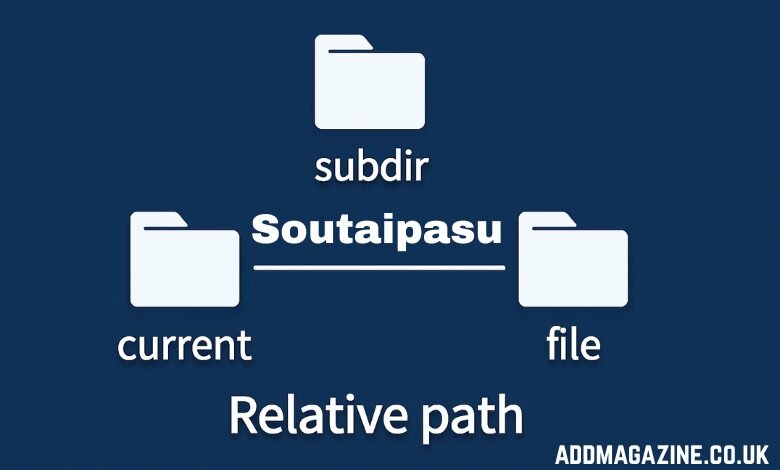The term “Soutaipasu” (相対パス or ソウタイパス) has recently gained attention, particularly in Japan, as it brings together both its technical roots and its more metaphorical and philosophical interpretations. A Japanese transliteration of the English term “relative path,” it has become a prominent expression in multiple spheres, particularly in web development, computer science, and even pop culture. While its literal meaning pertains to a technical concept, it has also taken on additional, figurative layers in various contexts, particularly in speculative fiction, anime, and manga. This blog post explores the origin, meaning, and diverse interpretations of “Soutaipasu” and how it has evolved in contemporary Japanese media.
The Technical Definition: Understanding the Basics of Relative Path
To fully grasp the significance of “Soutaipasu,” it’s essential to first understand the technical definition of its English counterpart, “relative path.” In the realm of computer science and web development, a relative path refers to a way of specifying the location of a file or directory in relation to the current working directory. Unlike an absolute path, which gives the full location from the root directory (e.g., /home/user/documents/), a relative path offers a shorter, more flexible reference, often represented by expressions like ./, ../, or simply a filename.
For example, in a website’s file structure, if you’re working in a folder and need to reference another file within the same directory, you could use a relative path, such as ./image.jpg. The idea is that it’s understood relative to the current directory, making it easier to move or copy directories around without breaking the link to internal resources.
In Japanese, the term “Soutaipasu” is simply the Japanese reading of the words “relative path.” The kanji “相対” (soutai) translates to “relative,” and “パス” (pasu) is a transliteration of “path.” This makes “Soutaipasu” a direct and precise translation of “relative path.”
The Popularization of Soutaipasu in Japanese Media
The term “Soutaipasu” has taken on additional meaning and significance within Japanese media, particularly in anime, manga, and speculative fiction. In these contexts, it has become a metaphor for concepts such as parallel paths, alternate realities, and relative existences. While this re-contextualization may have begun as a technical term, its adoption into fiction showcases how language evolves and adapts to fit the narrative needs of various creative fields.
In anime and manga, “Soutaipasu” is often used to describe characters’ journeys or pathways that are closely linked to their current circumstances but diverge in some way. For example, in stories involving parallel universes, time travel, or multiple outcomes, a character’s fate may be shown as a “relative path” to their original path, with each choice branching off into different potential realities. This usage aligns with how the term “relative path” operates in computer science: while the destination remains the same, the route to get there may differ depending on the chosen reference point.
This conceptualization aligns with the use of “Soutaipasu” in Japan’s vibrant speculative fiction genre, where it symbolizes an alternative path that isn’t necessarily the “main” one, but one that runs parallel, offering a different trajectory that may be just as significant. Whether in stories about multiple dimensions or time loops, the idea of “relative paths” allows creators to explore various interpretations of reality and existence. Characters in these worlds often experience parallel lives or alternative choices, each of which may be equally valid or important.
The Influence of Soutaipasu on Popular Culture
The impact of “Soutaipasu” is also felt in other aspects of Japanese culture beyond web development or fiction. The term has found its way into philosophy, psychology, and even daily conversations, as it embodies an intriguing way of thinking about the world. Much like how other technical terms are adopted into general language use, “Soutaipasu” carries a metaphysical weight in discussions of human experience.
Philosophically, the concept of “relative existence” (相対的な存在 or soutai-teki na sonzai) can be connected to the fundamental nature of reality: that one’s perception or understanding of the world is relative to their position, experiences, and interactions. In this sense, “Soutaipasu” not only represents the concept of alternative or parallel paths, but it can also be used to illustrate the subjective nature of human perception, where no single path is absolute but exists in relation to others.
This application is particularly relevant in the context of contemporary life, where people are more aware than ever of the relative nature of their choices and opportunities. In both digital and real worlds, there are often multiple “paths” one could take, each shaped by personal decisions, external influences, and uncontrollable circumstances.
Soutaipasu and The Rise of Digital Culture
In the digital age, the concept of “Soutaipasu” extends beyond its use in web development. As the internet grows more interconnected, ideas about virtual spaces, alternate realities, and digital spaces intersect in various fields, from gaming to social media, where users navigate “relative paths” through different platforms or personas.
For example, in the world of online gaming, players often embark on quests or journeys where each decision and action leads them down a relative path, with unique outcomes depending on choices made along the way. The concept of alternate realities within virtual spaces often mirrors the real world, where one’s path is determined by the current environment and interactions, much like the function of a relative path in file systems. The evolution of such virtual spaces, particularly in the context of role-playing games (RPGs) and open-world adventures, illustrates how the concept of relative existence is growing in popularity as a part of digital culture.
Furthermore, the idea of “Soutaipasu” resonates within the broader field of digital media, where the journey of an individual or a character is often portrayed as a relative path through various digital environments. Just as in coding or web development, where different URLs and files are connected through relative paths, digital identities and virtual spaces are similarly interlinked and navigated by the user or player.
Soutaipasu in Broader Philosophy and Metaphysics
Taking a more philosophical view, “Soutaipasu” can be understood as a reflection of how individuals experience their own lives. Just as a relative path depends on the current location of the user, an individual’s experience in life is shaped by their circumstances, upbringing, and choices. This means that each person’s path is not set in stone but instead is shaped dynamically by their experiences, relationships, and personal growth.
In this context, “Soutaipasu” has even been used to discuss existential themes. By imagining life as a series of relative paths, one can reflect on the nature of existence and the freedom inherent in the decisions we make. Life’s paths may be deeply connected to one another, but they are shaped uniquely for each person, in a way that mirrors the flexibility of relative paths in the digital world.
The Future of Soutaipasu in Japan and Beyond
As digital technology continues to evolve, so too will the concept of “Soutaipasu.” The ongoing development of virtual realities, artificial intelligence, and advanced web technologies means that the idea of navigating relative paths will likely become even more relevant in the future. For instance, as we explore the metaverse or engage with more complex, immersive digital worlds, the need for flexible, adaptable systems—much like relative paths—will become a cornerstone of virtual interaction.
In fiction and pop culture, the exploration of parallel universes and alternate realities continues to grow in popularity, from television shows like Steins;Gate to the global phenomenon of The Matrix. In these worlds, the notion of “Soutaipasu” presents an elegant metaphor for the fluidity of reality and existence, where every decision can lead to a new path, but none are necessarily superior or more “real” than others.
Conclusion
“Soutaipasu” serves as a bridge between technical and metaphysical realms, offering a unique perspective on both web development and life itself. From its humble beginnings as a term used in computer science to its wide-reaching influence in Japanese media, philosophy, and digital culture, “Soutaipasu” invites reflection on the nature of existence and the ways we navigate our lives. Whether as a technical reference or a metaphor for parallel realities, the concept encourages us to think about the many paths we walk, and how each choice leads to a new, equally valid destination. As technology advances, and as our understanding of digital spaces continues to deepen, “Soutaipasu” will undoubtedly remain an intriguing concept—one that invites us to reconsider how we understand our place in the world.




